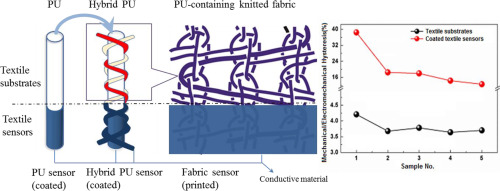当前位置:
X-MOL 学术
›
Mater. Des.
›
论文详情
Our official English website, www.x-mol.net, welcomes your feedback! (Note: you will need to create a separate account there.)
Investigation into tensile hysteresis of polyurethane-containing textile substrates for coated strain sensors
Materials & Design ( IF 8.4 ) Pub Date : 2020-03-01 , DOI: 10.1016/j.matdes.2019.108451 Qiao Li , Yuchi Wang , Shen Jiang , Ting Li , Xin Ding , Xiaoming Tao , Xi Wang
Materials & Design ( IF 8.4 ) Pub Date : 2020-03-01 , DOI: 10.1016/j.matdes.2019.108451 Qiao Li , Yuchi Wang , Shen Jiang , Ting Li , Xin Ding , Xiaoming Tao , Xi Wang

|
Abstract Flexible sensors based on the highly elastic Polyurethane (PU)-containing textile substrates have been frequently incorporated in enormous wearable applications. However, the desirable sensing properties such as stable sensitivity, small hysteresis and good repeatability depend on the mechanical resilience of the textile substrates. This paper conducts a systematic investigation into the mechanical hysteresis of the PU-containing textile substrates, from fibers to yarns and then fabrics. The impact of fiber materials, yarn structures, and fabric constructions on the overall tensile properties of the PU-containing substrates were examined. It was found that fibers of high elasticity, stable yarn structure with excellent recovery, as well as appropriate fabric construction are effective to reduce the mechanical hysteresis of the textile substrates. Coated strain sensors based on different substrates were then fabricated. Results show that smaller mechanical hysteresis of the PU-containing substrates generally led to lower electromechanical hysteresis and better repeatability of sensors. This paper gives all-round consideration of the fibers and structure features of substrates to provide recommendation for reducing mechanical and electromechanical hysteresis of sensors based on PU-containing textiles and benefiting the design and optimization of other flexible sensors.
中文翻译:

用于涂层应变传感器的含聚氨酯织物基材的拉伸滞后研究
摘要 基于含有高弹性聚氨酯 (PU) 的纺织基材的柔性传感器经常被用于大量的可穿戴应用中。然而,理想的传感特性,如稳定的灵敏度、小滞后和良好的可重复性,取决于纺织品基材的机械弹性。本文对含 PU 的纺织基材(从纤维到纱线再到织物)的机械滞后进行了系统研究。研究了纤维材料、纱线结构和织物结构对含 PU 基材的整体拉伸性能的影响。发现具有高弹性、稳定的纱线结构和极好的回复率的纤维,以及适当的织物结构可有效减少纺织品基材的机械滞后。然后制造基于不同基板的涂层应变传感器。结果表明,含 PU 基材的较小机械滞后通常会导致较低的机电滞后和更好的传感器重复性。本文全面考虑了基材的纤维和结构特征,为降低基于含PU纺织品的传感器的机械和机电滞后提供建议,并有利于其他柔性传感器的设计和优化。结果表明,含 PU 基材的较小机械滞后通常会导致较低的机电滞后和更好的传感器重复性。本文全面考虑了基材的纤维和结构特征,为降低基于含PU纺织品的传感器的机械和机电滞后提供建议,并有利于其他柔性传感器的设计和优化。结果表明,含 PU 基材的较小机械滞后通常会导致较低的机电滞后和更好的传感器重复性。本文全面考虑了基材的纤维和结构特征,为降低基于含PU纺织品的传感器的机械和机电滞后提供建议,并有利于其他柔性传感器的设计和优化。
更新日期:2020-03-01
中文翻译:

用于涂层应变传感器的含聚氨酯织物基材的拉伸滞后研究
摘要 基于含有高弹性聚氨酯 (PU) 的纺织基材的柔性传感器经常被用于大量的可穿戴应用中。然而,理想的传感特性,如稳定的灵敏度、小滞后和良好的可重复性,取决于纺织品基材的机械弹性。本文对含 PU 的纺织基材(从纤维到纱线再到织物)的机械滞后进行了系统研究。研究了纤维材料、纱线结构和织物结构对含 PU 基材的整体拉伸性能的影响。发现具有高弹性、稳定的纱线结构和极好的回复率的纤维,以及适当的织物结构可有效减少纺织品基材的机械滞后。然后制造基于不同基板的涂层应变传感器。结果表明,含 PU 基材的较小机械滞后通常会导致较低的机电滞后和更好的传感器重复性。本文全面考虑了基材的纤维和结构特征,为降低基于含PU纺织品的传感器的机械和机电滞后提供建议,并有利于其他柔性传感器的设计和优化。结果表明,含 PU 基材的较小机械滞后通常会导致较低的机电滞后和更好的传感器重复性。本文全面考虑了基材的纤维和结构特征,为降低基于含PU纺织品的传感器的机械和机电滞后提供建议,并有利于其他柔性传感器的设计和优化。结果表明,含 PU 基材的较小机械滞后通常会导致较低的机电滞后和更好的传感器重复性。本文全面考虑了基材的纤维和结构特征,为降低基于含PU纺织品的传感器的机械和机电滞后提供建议,并有利于其他柔性传感器的设计和优化。



























 京公网安备 11010802027423号
京公网安备 11010802027423号